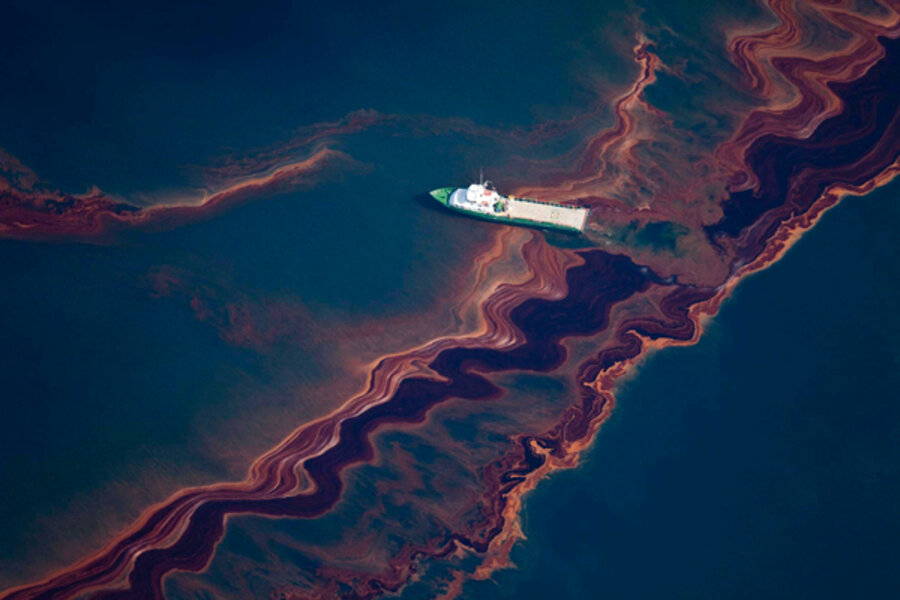Golf balls, new containment dome on deck to stop Gulf oil spill
Loading...
A four-story containment dome meant to restrict oil from gushing further into the Gulf of Mexico failed this weekend, leaving recovery officials to move forward with alternate plans, none of which have been tested 5,000 feet below the water’s surface.
The extreme depth remains the greatest challenge in trying to stop the release of the 210,000 gallons of oil per day that have been spewing from an undersea well off the coast of Louisiana since a blowout caused the Deepwater Horizon rig to explode April 20.
BP, the well owner and tanker operator, is blaming a failed blowout preventer, an underwater valve designed to stop leaks, for the spill. Efforts to prevent the oil from spreading include spreading chemical dispersant from planes to break up the oil’s consistency, as well as laying a million miles of boom to absorb the oil before it reaches the gulf shore.
IN PICTURES: Destructive oil spills
“This is the largest, most comprehensive spill response in the history of the US in the oil and gas industry and it actually has done, in many people’s estimations, a very good job of containment,” BP Chief Executive Tony Hayward said in a conference call with reporters Monday.
But just because oil is not washing ashore does not mean it is not on its way. The rate of the oil’s movement relies on a combination of wind and ocean currents, both of which were calm last week due to good weather. The oil’s consistency may also be such that it is infiltrating the water column below the surface.
So far, oil has washed up in three places: along the Chandeleur Islands, a 50-mile chain that lines Louisiana’s Southeastern coast; on a beach at the mouth of the South Pass, one of the navigable channels of the Mississippi; and Dauphin Island, off the Alabama coast. Oil-slicked waterfowl have been discovered, and dead sea turtles continue to appear along the Mississippi and Louisiana coasts. On Monday, US Coast Guard Rear Adm. Mary Landry said the oil’s next landfall might be Grand Isle, a barrier island off the Louisiana coast.
Containment efforts were thwarted this weekend after methanol combined with freezing undersea water crystallized in the dome, making it buoyant. While BP engineers are considering ways to address the problem, two more containment efforts are being planned for as early as later this week.
The first is a smaller containment dome BP is calling the “Top Hat.” The four-by-five foot, two-ton dome works in much the same way as its larger version, but according to BP senior executive vice-president Kent Wells, it will do a better job separating water from the gas. Mr. Wells says operating a smaller dome “will be a little more tricky,” but it will “pump methanol in [the well] to stop hydrates from forming. You couldn’t do that in a large vessel, but in a smaller vessel, we believe it will work.” He said engineers are prepared to lower the device by the end of this week.
The following week officials plan to try the “Junk Shot,” a procedure that involves diverting the flow of oil with several blasts of material including golf balls and rubber tire shards, and then cementing over the opening once it is plugged. “There’s a little bit of science in it even though it sounds odd,” Wells said.
At the center of the recovery effort are two relief wells, which are being drilled 40 miles off the Louisiana coast and will be used to pump cement into the leak and seal it. Drilling of the first well started last week and will take 90 days to complete. The drilling of a second well will start next week.
The risks include unpredictable weather, since the wells will be operational at the start of hurricane season. The wells are also being drilled into the same mix of oil and gas that caused the original explosion, and operating two wells in the area creates the potential of igniting a second explosion that is more powerful. On Monday Bloomberg reported that in BP’s regulatory filing to drill the wells, it included the estimation that a second blowout would release up to 240,000 barrels of oil a day into the ocean.
When asked about these possibilities Monday, Mr. Hayward said “the relief wells ultimately will be successful.”
BP is assembling a global team of scientists and oil industry experts in its US headquarters in Houston to test solutions. Because the situation is unprecedented, BP is considering all possibilities, which includes soliciting ideas from the public. So far BP has received “literally thousands” of ideas from outside the company, Wells reported.
“We take all of them … we appreciate what we’re getting externally,” he said.
IN PICTURES: Destructive oil spills
Related:





